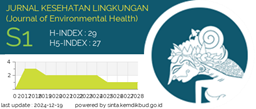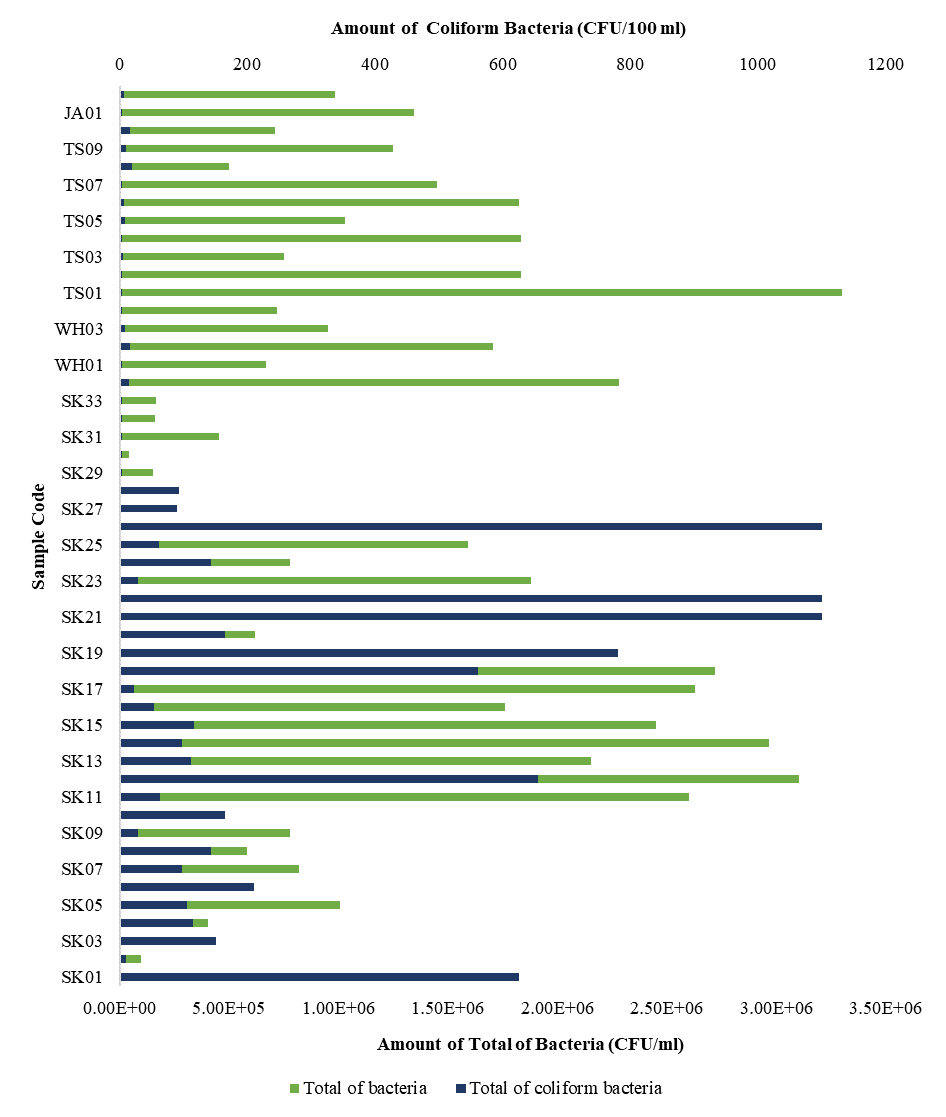Human Health Risk Assessment of Heavy Metals in the Serayu River Water, Central Java-Indonesia

Introduction: Pollution is a major factor contributing to the decline in river water quality, which serves as a source of clean water for residents. This study examines the pollution degrees of heavy metals, including lead, cadmium, chromium, nickel, arsenic, cobalt, and manganese, in surface water, as well as the associated public health risks for adults and children. Methods: Water samples were obtained from 18 unique sites along the Serayu River in Central Java Province. The concentrations of heavy metals were measured utilizing an Atomic Absorption Spectrophotometer. The heavy metal pollution index was employed to evaluate the Serayu River's suitability as drinking water. Public health risks were evaluated by employing the hazard quotient (HQ), hazard index (HI), and carcinogenic risk estimation. Results and Discussion: The heavy metal pollution index exceeded 100 at several sampling sites (W1, W2, W3, W4, W6, W7), indicating that the water is unsafe for drinking. However, non-carcinogenic risks from metal ingestion are negligible, as the HI and HQ values for both adults and children remain below one. The estimated carcinogenic risk is within the acceptable threshold (1E-4), with values of 1.109E-6 for adults and 4.199E-6 for children, suggesting no significant carcinogenic risk to the population. Conclusion: The results indicate that the Serayu River does not pose a significant carcinogenic or non-carcinogenic for illness to adults and children. However, owing to their heightened susceptibility to toxic effects, monitoring strategies to address the elevated vulnerability of children to heavy metal exposure
Parvin F, Haque MM, Tareq SM. Recent Status of Water Quality in Bangladesh: A Systematic Review, Meta-Analysis and Health Risk Assessment. Environmental Challenges. 2022;6(1):1-10 https://doi.org/10.1016/j.envc.2021.100416
Rahman K, Barua S, Imran HM. Assessment of Water Quality and Apportionment of Pollution Sources of An Urban Lake Using Multivariate Statistical Analysis. Cleaner Engineering and Technology. 2021;5(1):1-13. https://doi.org/10.1016/j.clet.2021.100309
Sang C, Tan L, Cai Q, Ye L. Long-term (2003−2021) Evolution Trend of Water Quality in the Three Gorges Reservoir: An Evaluation Based on An Enhanced Water Quality Index. Science of the Total Environment. 2024;915(1):1-13. https://doi.org/10.1016/j.scitotenv.2023.169819
Suriadikusumah A, Mulyani O, Sudirja R, Sofyan ET, Maulana MHR, Mulyono A. Analysis of the Water Quality at Cipeusing River, Indonesia Using the Pollution Index Method. Acta Ecologica Sinica. 2021;41(3):177–182. https://doi.1org/10.1016/J.CHNAES.2020.08.001
Cordova MR, Nurhati IS, Shiomoto A, Hatanaka K, Saville R, Riani E. Spatiotemporal Macro Debris and Microplastic Variations Linked to Domestic Waste and Textile Industry in the Supercritical Citarum River, Indonesia. Mar Pollut Bull. 2022;175(1):1-11. https://doi.org/10.1016/j.marpolbul.2022.113338
Kustamar, Wulandari LK. The Pollution Index and Carrying Capacity of The Upstream Brantas River. International Journal of GEOMATE. 2020;19(73):26–32. https://doi.org/10.21660/2020.73.55874
Rachmawati S, Setyono P, Wiraatmaja MF, Helmi R, Rahadian MR, Nugroho ME. Analysis of Water Quality Kedung Pedhet River, Mojosongo, Surakarta. Mater Today Proc. 2022;63(1):S513-S519. https://doi.org/10.1016/j.matpr.2022.04.863
Mitra S, Chakraborty AJ, Tareq AM, Emran T Bin, Nainu F, Khusro A, et al. Impact of Heavy Metals on the Environment and Human Health: Novel Therapeutic Insights to Counter the Toxicity. J King Saud Univ Sci. 2022;34(3):1-23. https://doi.org/10.1016/j.jksus.2022.101865
Fahimah N, Salami IRS, Oginawati K, Mubiarto H. Appraisal of Pollution Levels and Non-Carcinogenic Health Risks Associated with the Emergence of Heavy Metals in Indonesian Community Water for Sanitation, Hygiene, and Consumption. Emerg Contam. 2024;10(3):1-20. https://doi.org/10.1016/j.emcon.2024.100313
Marin Villegas CA, Zagury GJ. Incorporating Oral, Inhalation and Dermal Bioaccessibility into Human Health Risk Characterization Following Exposure to Chromated Copper Arsenate (CCA)-Contaminated Soils. Ecotoxicol Environ Saf. 2023;249(1):1-11. https://doi.org/10.1016/j.ecoenv.2022.114446
Eid MH, Eissa M, Mohamed EA, Ramadan HS, Tamás M, Kovács A, et al. New Approach into Human Health Risk Assessment Associated with Heavy Metals in Surface Water and Groundwater Using Monte Carlo Method. Sci Rep. 2024;14(1):1–20. https://doi.org/10.1038/s41598-023-50000-y
Saeedi R, Sadeghi S, Massoudinejad M, Oroskhan M, Mohagheghian A, Mohebbi M, et al. Assessing Drinking Water Quality Based on Water Quality Indices, Human Health Risk, and Burden of Disease Attributable to Heavy Metals in Rural Communities of Yazd County, Iran, 2015–2021. Heliyon. 2024;10(13):1-13. https://doi.org/10.1016/j.heliyon.2024.e33984
Angali KA, Farhadi M, Neisi A, Cheraghian B, Ahmadi M, Takdastan A, et al. Carcinogenic and Non-Carcinogenic Risks Caused by Rice Contamination with Heavy Metals and Their Effect on the Prevalence of Cardiovascular Disease (Using Machine Learning). Food and Chemical Toxicology. 2024;194(1):1-13. https://doi.org/10.1016/j.fct.2024.115085
Chang Z, Qiu J, Wang K, Liu X, Fan L, Liu X, et al. The Relationship Between Co-Exposure to Multiple Heavy Metals and Liver Damage. Journal of Trace Elements in Medicine and Biology. 2023;77(1):1-9. https://doi.org/10.1016/j.jtemb.2023.127128
Pozdnyakova N, Krisanova N, Pastukhov A, Dudarenko M, Tarasenko A, Borysov A, et al. Multipollutant Reciprocal Neurological Hazard from Smoke Particulate Matter and Heavy Metals Cadmium and Lead in Brain Nerve Terminals. Food and Chemical Toxicology. 2024;185(1);1-13. https://doi.org/10.1016/j.fct.2024.114449
Bhat AA, Moglad E, Bansal P, Kaur H, Deorari M, Thapa R, et al. Pollutants to Pathogens: The Role of Heavy Metals in Modulating TGF-Β Signaling and Lung Cancer Risk. Pathology Research and Practice. 2024:256(1):1-12. https://doi.org/10.1016/j.prp.2024.155260
Ministry of Environment and Forestry of Republic Indonesia. Baseline Report of Serayu River Basin Management 2020. Jakarta: Ministry of Environment and Forestry of Republic Indonesia; 2020.
Rustanto A. Dinamika Erosi Tanah dan Krisis Ekonomi-Era Reformasi di Daerah Aliran Sungai Serayu Hulu. Jurnal Geografi Lingkungan Tropik. 2019;3(1):41-47. https://doi.org/10.7454/jglitrop.v3i1.70
Sehah, Kurniawan MA, Andriyanto I, Arismawan B, Risyad A, Wibowo AM, et al. Estimation of Potential of Iron Sand in the Eastern Coastal Area of Cilacap Regency Based on the Local Magnetic Anomalies Data. Journal of Physics: Conference Series. 2020;1494(1):1-11. https://doi.org/10.1088/1742-6596/1494/1/012038
Hardanto A, Mustofa A, Ardiansyah A. Water Recharge Variability Across Serayu Watershed Using Soil Water Assessment Tool (SWAT). Proceeding ICMA-SURE. 2023;2(1):1-8. https://doi.org/10.20884/2.procicma.2023.2.1.8425
Chowdhury AN, Naher S, Likhon MNA, Hassan J, Fariha ZN, Hasan MR, et al. Heavy Metal (Pb, Cd and Cr) Contamination and Human Health Risk Assessment of Groundwater in Kuakata, Southern Coastal Region of Bangladesh. Geosystems and Geoenvironment. 2025;4(1):1-12. https://doi.org/10.1016/j.geogeo.2024.100325
Jazza SH, Najim SS, Adnan MA. Using Heavy Metals Pollution Index (HPI) for Assessment Quality of Drinking Water in Maysan Province in Southern East in Iraq. Egypt J Chem. 2022;65(2):703–709. https://doi.org/10.21608/EJCHEM.2021.89658.4295
El Morabet R, Barhazi L, Bouhafa S, Dahim MA, Khan RA, Dahim AM. Water Quality, Heavy Metal Contamination and Health Risk Assessment of Surface Water Bodies of Mohammedia Prefecture, Morocco. Environmental Chemistry and Ecotoxicology. 2024;6(1):33–41. https://doi.org/10.1016/j.enceco.2023.12.002
Le TV, Nguyen BT. Heavy Metal Pollution in Surface Water Bodies in Provincial Khanh Hoa, Vietnam: Pollution and Human Health Risk Assessment, Source Quantification, and Implications for Sustainable Management and Development. Environmental Pollution. 2024;343(1):1-10. https://doi.org/10.1016/j.envpol.2023.123216
Kan X, Dong Y, Feng L, Zhou M, Hou H. Contamination and Health Risk Assessment of Heavy Metals in China’s Lead–Zinc Mine Tailings: A Meta–Analysis. Chemosphere. 2021;267(1):1-9. https://doi.org/10.1016/j.chemosphere.2020.128909
Ogarekpe NM, Nnaji CC, Oyebode OJ, Ekpenyong MG, Ofem OI, Tenebe IT, et al. Groundwater Quality Index and Potential Human Health Risk Assessment of Heavy Metals in Water: A Case Study of Calabar Metropolis, Nigeria. Environ Nanotechnol Monit Manag. 2023;19(1):1-13. https://doi.org/10.1016/j.enmm.2023.100780
Government of Republic Indonesia. Regulation of Government No. 22 Year 2021 about Implementation of Environmental Protection and Management, National Water Quality Standards. Jakarta; Main Directorate of Legal Development and Development of State Financial Audit of the Audit Board of Indonesia: 2021.
Huang H, Guan H, Tian ZQ, Chen MM, Tian KK, Zhao FJ, et al. Exposure Sources, Intake Pathways and Accumulation of Lead in Human Blood. Soil Security. 2024;15(1):1-9. https://doi.org/10.1016/j.soisec.2024.100150
Shao K, Yu Y, Ritz B, Paul KC. DNA Methylation Biomarkers for Cumulative Lead Exposures and Cognitive Impairment. Environ Res. 2025;264(2):1-7. https://doi.org/10.1016/j.envres.2024.120304
Ali Daoud Y, Tebby C, Beaudouin R, Brochot C. Development of a Physiologically Based Toxicokinetic Model for Lead in Pregnant Women: The Role of Bone Tissue in the Maternal and Fetal Internal Exposure. Toxicol Appl Pharmacol. 2023;476(1):1-13. https://doi.org/10.1016/j.taap.2023.116651
Ali MU, Gulzar MZ, Sattar B, Sehar S, Abbas Q, Adnan M, et al. Silent Threats of Lead-Based Paints in Toys and Households to Children’s Health and Development. Journal of Hazardous Materials. 2025;486(1):1-12. https://doi.org/10.1016/j.jhazmat.2024.136984
Abdulhai F, Motairek I, Mirzai S, Bazarbachi B, Chamseddine F, Alamer M, et al. Quantifying Lead-Attributable Cardiovascular Disease Burden in the United States. Current Problems in Cardiology. 2024;49(6):1-3. https://doi.org/10.1016/j.cpcardiol.2024.102565
Upadhyay K, Viramgami A, Bagepally BS, Balachandar R. Association Between Chronic Lead Exposure and Markers of Kidney Injury: A Systematic Review and Meta-Analysis. Toxicol Rep. 2024;13(1):1-14. https://doi.org/10.1016/j.toxrep.2024.101837
Wang Z, Zhang J, Watanabe I. Source Apportionment and Risk Assessment of Soil Heavy Metals due to Railroad Activity Using A Positive Matrix Factorization Approach. Sustainability. 2023;15(1):1-15. https://doi.org/10.3390/su15010075
Xiongyi M, Longli C, Yupei H, Jing A, Tiantian X, Wei B, et al. The Variations of Heavy Metals Sources Varied Their Aggregated Concentration and Health Risk in Sediments of Karst Rivers – A Case Study in Liujiang River Basin, Southwest China. Mar Pollut Bull. 2024;201(1):1-9. https://doi.org/10.1016/j.marpolbul.2024.116171
Sukarjo, Handayani CO, Sp Rahayu H, Hidayat S. Assesment of Contamination Level and Source Apportionment of Heavy Metals in Serayu River Water, Indonesia. International Journal of Conservation Science. 2023;14(4):1641-1658. https://doi.org/10.36868/IJCS.2023.04.26
Zhen H, Jia L, Huang C, Qiao Y, Li J, Li H, et al. Long-term Effects of Intensive Application of Manure on Heavy Metal Pollution Risk in Protected-Field Vegetable Production. Environmental Pollution. 2020;263(1):1–10. https://doi.org/10.1016/j.envpol.2020.114552
Listyani R.A. T, Budiadi E, Misdiyanta P. Inventarisasi Manifestasi Panasbumi dan Potensi Geowisata di Provinsi Jawa Tengah. Jurnal Pengabdian Masyarakat Progresif Humanis Brainstorming. 2022;5(1):14-21. https://doi.org/10.30591/japhb.v5i1.2836
Larasati AB, Pujiyono P, Azhar M. Pendekatan Penal Dalam Kerangka Politik Kriminal Untuk Menanggulangi Tindak Pidana Tambang Galian C di Wilayah Wonosobo. Jurnal Pembangunan Hukum Indonesia. 2021;3(1):121-135. https://doi.org/10.14710/jphi.v3i1.121-135
Agwu EJ, Odanwu SE, Ezewudo BI, Odo GE, Nzei JI, Iheanacho SC, et al. Assessment of water quality status using heavy metal pollution indices: A case from Eha-Amufu catchment area of Ebonyi River, Nigeria. Acta Ecologica Sinica. 2023;43(6):989–1000. https://doi.org/10.1016/j.chnaes.2023.02.003
Uugwanga MN, Kgabi NA. Heavy Metal Pollution Index of Surface and Groundwater from Around An Abandoned Mine Site, Klein Aub. Physics and Chemistry of the Earth. 2021;124(1):1-8. https://doi.org/10.1016/j.pce.2021.103067
Turasih T. Transformasi Sosial Petani Kentang di Dataran Tinggi Dieng. Jurnal Empower: Jurnal Pengembangan Masyarakat Islam. 2019;4(2):279-298. https://doi.org/10.24235/empower.v4i2.5462
Cheng C, Fan B, Yang Y, Wang P, Wu M, Xia H, et al. Construction of An Adverse Outcome Pathway Framework for Arsenic-Induced Lung Cancer Using A Network-Based Approach. Ecotoxicol Environ Saf. 2024;283(1):1-10. https://doi.org/10.1016/j.ecoenv.2024.116809
Hwang J hyun, An GJ, Kim CH, Chung HY, Lim K min. Trivalent Arsenicals Induce Skin Toxicity Through Thiol Depletion. Toxicol Appl Pharmacol. 2024;492(1):1-10. https://doi.org/10.1016/j.taap.2024.117115
Hasan NT, Xu X, Han D, Sansom G, Roh T. Association Between Urinary Arsenic Levels and Kidney Damage In US Adults: NHANES 2007–2018. Journal of Trace Elements in Medicine and Biology. 2024;86(1):1-8. https://doi.org/10.1016/j.jtemb.2024.127559
Meakin CJ, Szilagyi JT, Avula V, Fry RC. Inorganic Arsenic and Its Methylated Metabolites as Endocrine Disruptors in The Placenta: Mechanisms Underpinning Glucocorticoid Receptor (GR) Pathway Perturbations. Toxicol Appl Pharmacol. 2020;409(1):1-10. https://doi.org/10.1016/j.taap.2020.115305
Hong D, Min JY, Min KB. Association Between Cadmium Exposure and Liver Function in Adults in The United States: A Cross-Sectional Study. Journal of Preventive Medicine and Public Health. 2021;54(6):471-480. https://doi.org/10.3961/jpmph.21.435
Ciosek Ż, Kot K, Rotter I. Iron, Zinc, Copper, Cadmium, Mercury, and Bone Tissue. Vol. 20, International Journal of Environmental Research and Public Health. 2023;20(3):1-25. https://doi.org/10.3390/ijerph20032197
Handayani CO, Sukarjo, Zu’amah H, Dewi T. Assessment of Ecological and Public Health Risks Associated with Heavy Metals on Farmland in Wonosobo Regency, Indonesia. Journal of Degraded and Mining Lands Managemen. 2024;11(4):6143–6152. https://doi.org/doi:10.15243/jdmlm.2024.114.6143
Nyambura C, Hashim NO, Chege MW, Tokonami S, Omonya FW. Cancer and non-Cancer Health Risks from Carcinogenic Heavy Metal Exposures in Underground Water from Kilimambogo, Kenya. Groundw Sustain Dev. 2020;10(1):1-5. https://doi.org/10.1016/j.gsd.2019.100315

This work is licensed under a Creative Commons Attribution-NonCommercial-ShareAlike 4.0 International License.
1. Copyright of all journal manuscripts is held by the Jurnal Kesehatan Lingkungan.2. Formal legal provisions to access digital articles of electronic journal are subject to the provision of the Creative Commons Attribution-ShareAlike license (CC BY-NC-SA), which means that Jurnal Kesehatan Lingkungan is rightful to keep, transfer media/format, manage in the form of databases, maintain, and publish articles.
3. Published manuscripts both printed and electronic are open access for educational, research, and library purposes. Additionally, the editorial board is not responsible for any violations of copyright law.
JKESLING by UNAIR is licensed under a Creative Commons Attribution-ShareAlike 4.0 International License.







































